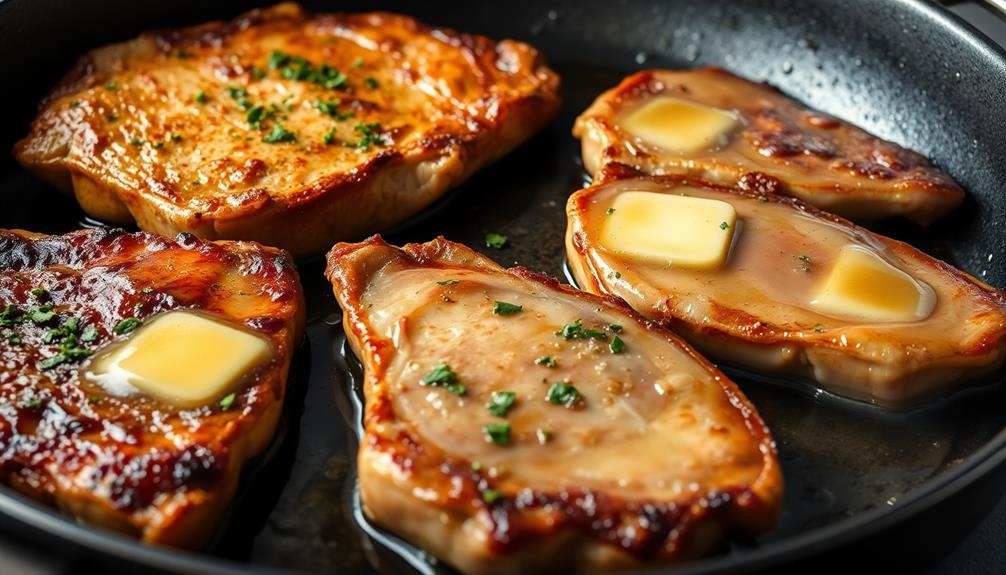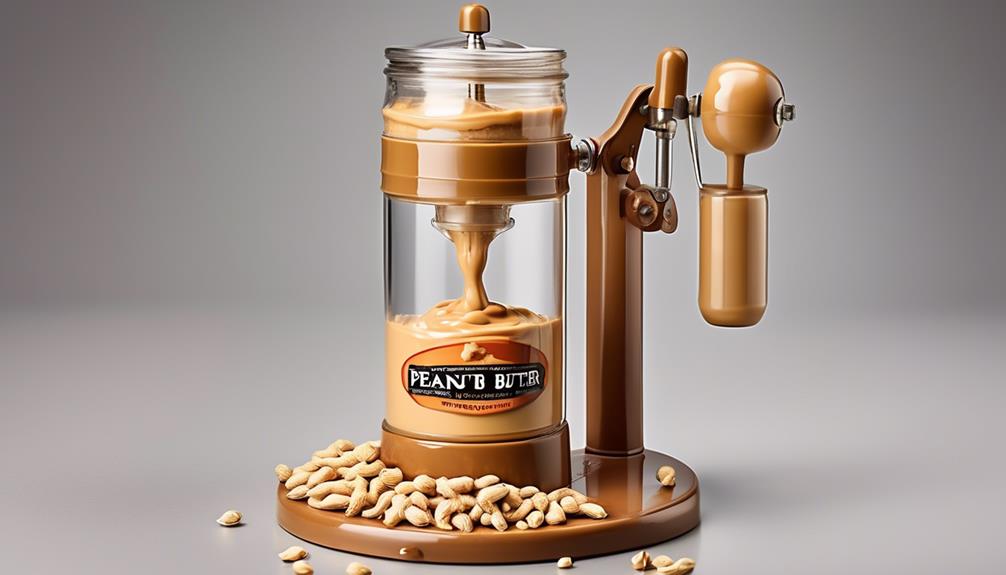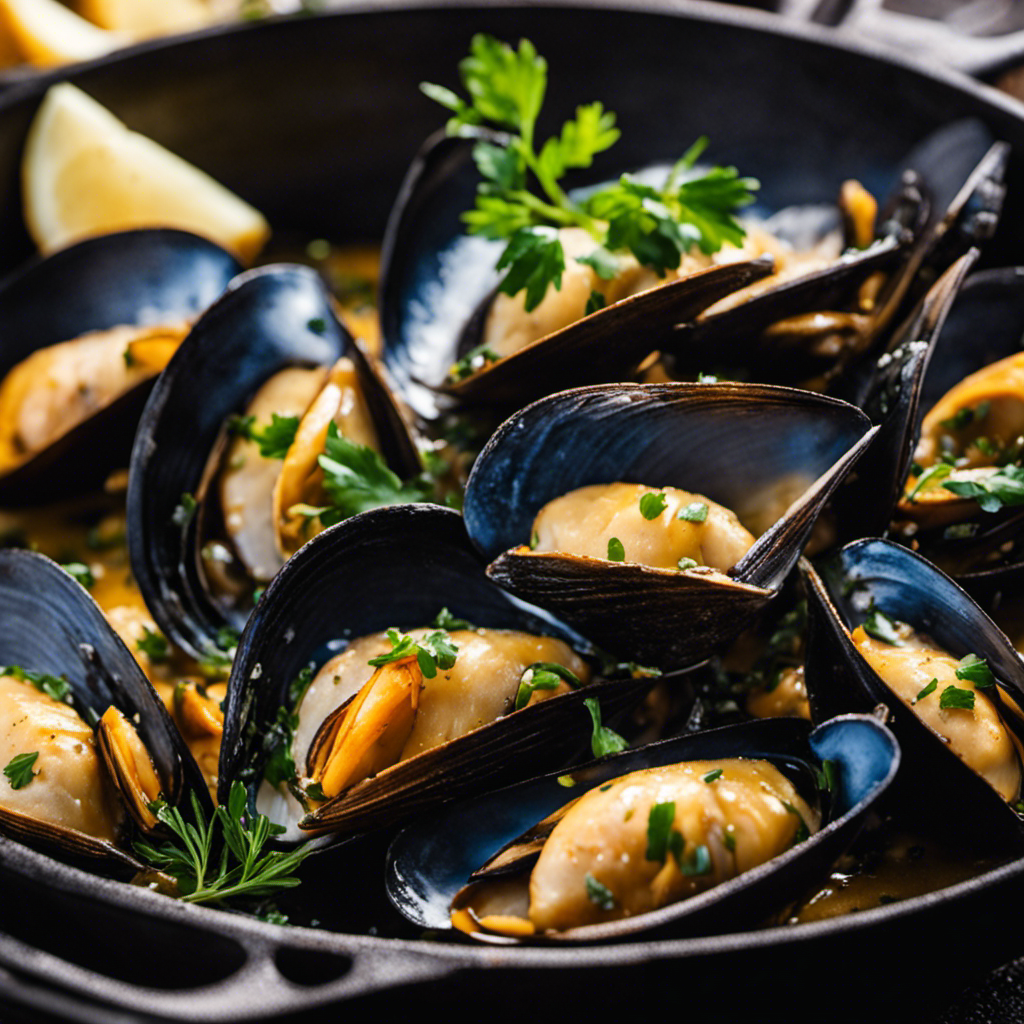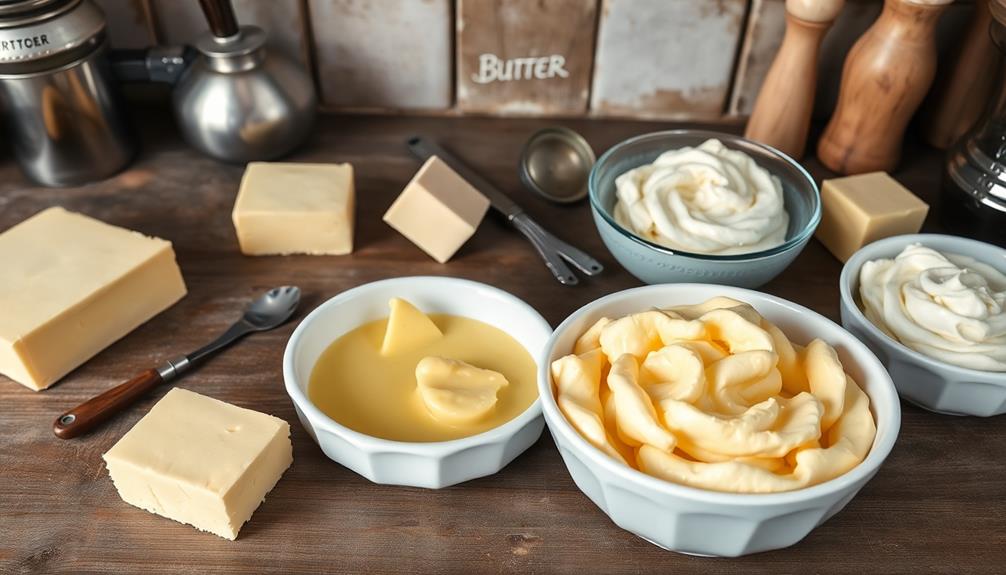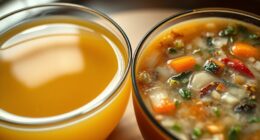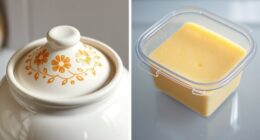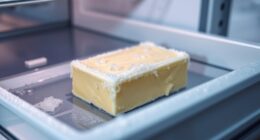Butter basting is a fantastic way to enhance the flavor and juiciness of meats. For steak, sear it on medium-high heat, then add a mix of melted butter and herbs like thyme or garlic while cooking. With chicken, use bone-in, skin-on cuts and baste frequently to keep it moist and flavorful. When grilling pork chops, choose thick cuts and baste with garlic-infused butter towards the end of cooking for extra richness. Experimenting with different herbs and spices in your butter mix can transform your dishes. Stick around to discover even more techniques and tips for perfecting your butter basting skills!
Key Takeaways
- Choose the Right Meat Cuts: Opt for bone-in, thicker cuts like steak, chicken, or pork chops to retain moisture and enhance flavor during basting.
- Preheat Your Cooking Surface: Always start with a medium-high heat skillet or grill to achieve a good sear and maintain juiciness while cooking.
- Season Generously: Use salt and pepper liberally on the meat to elevate its natural flavors before starting the basting process.
- Incorporate Flavorful Ingredients: Melt unsalted butter with fresh herbs and garlic to enhance the taste, drizzling it over the meat frequently while cooking.
- Rest Meat After Cooking: Allow the meat to rest post-cooking to let the juices redistribute, ensuring optimal tenderness and flavor in each bite.
Essential Tools for Butter Basting

To achieve the perfect butter-basted meat, you'll need a few essential tools. First, grab a heavy-duty skillet or a cast-iron pan. These materials retain heat well and guarantee an even cooking surface, which is critical for basting effectively.
Next, you'll want a good pair of tongs. They'll help you easily flip the meat without piercing it, allowing those delicious juices to stay locked inside.
You'll also need a basting brush or spoon. This tool allows you to drizzle melted butter and herbs over your meat, enhancing the flavor and moisture.
Don't forget a meat thermometer. It's essential for checking doneness without cutting into your meat, keeping those juices intact.
Finally, have some fresh herbs, like thyme or rosemary, on hand to infuse the butter with additional flavors.
With these tools, you're set to create succulent, butter-basted dishes that impress. Each item plays a significant role, guaranteeing you control the cooking process and achieve that rich, savory finish.
Investing in quality tools will make your butter basting experience enjoyable and rewarding. Happy cooking!
Butter Basting Steak Techniques
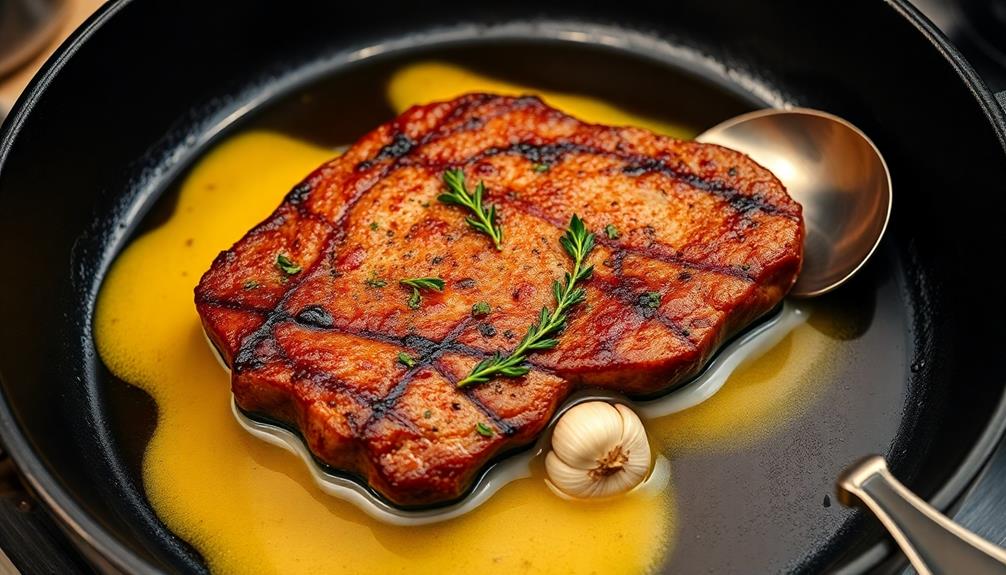
Butter basting steak is a game-changer that elevates your grilling or pan-searing experience. This technique infuses rich flavor and moisture into your steak, creating a mouthwatering crust.
Start by preheating your grill or skillet over medium-high heat. Pat your steak dry, season it generously with salt and pepper, and add a little oil to the pan to prevent sticking.
Once your steak hits the heat, let it sear without moving it for a few minutes until a crust forms. Then, add a couple of tablespoons of unsalted butter, along with aromatics like garlic or thyme. As the butter melts, tilt the pan and use a spoon to scoop up the melted butter, basting it over the steak.
Continue this process until your steak reaches your desired level of doneness, typically around 3-5 minutes per side for medium-rare. Don't forget to use a meat thermometer for accuracy!
Once done, let the steak rest for a few minutes to allow the juices to redistribute. Slice it up and enjoy the enhanced flavor and tenderness that butter basting brings to your steak experience.
Perfecting Chicken With Butter
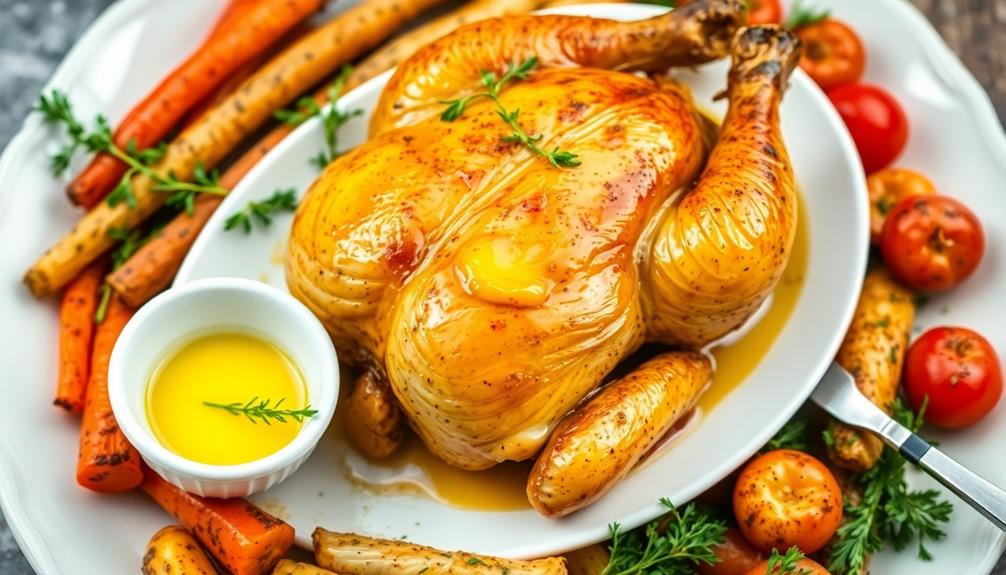
While steak benefits greatly from butter basting, chicken can also reach new heights with this simple technique. By adding butter to your cooking process, you enhance the flavor and moisture of the meat, creating a juicy, succulent dish.
This method is particularly effective with butter's creamy texture, which contributes to the overall richness of the dish. Here's how to perfect chicken with butter basting:
- Choose the Right Cut: Opt for bone-in, skin-on pieces like thighs or breasts. These cuts hold moisture better and benefit more from the basting process.
- Prep Your Butter: Melt unsalted butter and infuse it with herbs like thyme or rosemary for an aromatic twist. You can also add garlic for an extra layer of flavor.
- Baste Frequently: As your chicken cooks, use a spoon to drizzle the melted butter over the meat every few minutes. This keeps the surface crispy while locking in moisture.
- Monitor Temperature: Use a meat thermometer to verify your chicken reaches 165°F (75°C). This guarantees it's cooked through while remaining tender.
With these steps, you'll transform your chicken into a buttery masterpiece that's sure to impress at any dinner table. Enjoy the delicious results!
Grilling Pork Chops With Butter
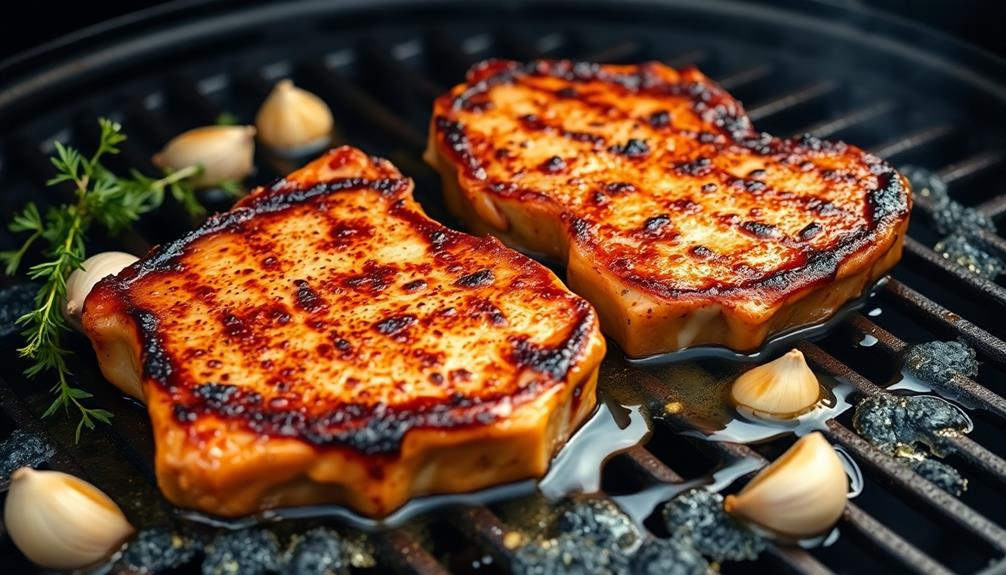
Grilling pork chops can elevate your outdoor cooking game, and incorporating butter into the process makes them even more delicious.
Start by selecting thick, bone-in pork chops for juiciness. Preheat your grill to medium-high heat, ensuring the grates are clean and well-oiled.
Season the pork chops with salt and pepper, or your favorite dry rub. Once the grill's hot, place the chops on it, searing them for about 4-5 minutes on each side. This initial sear locks in the juices and creates a beautiful crust.
Now's the time to add the butter. In a small saucepan, melt a few tablespoons of butter with some minced garlic and fresh herbs, such as thyme or rosemary.
As the pork chops finish cooking, use a spoon to baste them with the melted butter, turning them frequently. This adds flavor and moisture, keeping the meat tender.
Grill the chops until they reach an internal temperature of 145°F. Once done, let them rest for a few minutes before serving.
This resting period allows the juices to redistribute, giving you a succulent, flavorful bite. Enjoy your perfectly grilled pork chops!
Tips for Flavorful Butter Blends
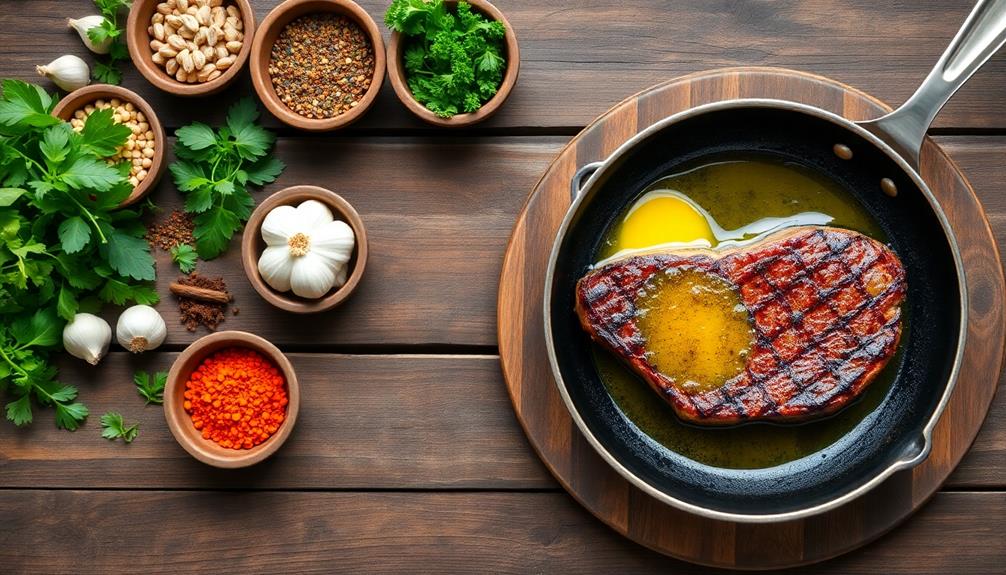
Elevating your butter blends can make a world of difference in the flavors of your meats. By customizing your butter, you can enhance the natural taste of your cuts and impress your guests. Here are some tips to create flavorful butter blends that will elevate your dishes:
- Herbs: Fresh herbs like rosemary, thyme, or parsley can add a burst of freshness. Chop them finely and mix them into softened butter for a vibrant flavor.
- Garlic: Incorporating minced garlic or roasted garlic into your butter brings a rich, savory element. Be mindful of the amount, as it can easily overpower other flavors.
- Spices: Experiment with spices like smoked paprika, cumin, or black pepper. A pinch can add depth and warmth, making your butter blend unique.
- Citrus Zest: Adding lemon or orange zest provides a bright, zesty kick. This can cut through the richness of the butter and enhance the overall flavor profile.
Frequently Asked Questions
Can I Use Margarine Instead of Butter for Basting?
You can use margarine instead of butter for basting, but it won't provide the same rich flavor. Margarine has a higher water content, which may affect the overall taste and browning of your dish.
How Often Should I Baste While Cooking?
You should baste every 15 to 30 minutes while cooking. This keeps the meat moist and flavorful. Just remember not to open the oven too often, or you'll lose heat and extend cooking time.
What Is the Ideal Temperature for Butter Basting?
When butter basting, aim for a cooking temperature between 350°F and 400°F. This range allows the butter to melt nicely, enhancing flavor while ensuring your meat cooks evenly and retains moisture. Don't rush the process!
Is It Safe to Reuse Basting Butter?
Reusing basting butter isn't recommended. It can harbor bacteria from the meat, increasing food safety risks. If you want to save it, strain it and use it for cooking at a later time.
Can I Add Herbs Directly to the Basting Butter?
You can totally add herbs directly to your basting butter. It'll explode with flavor, turning your dish into an unforgettable masterpiece. Just mix it well and watch your taste buds dance with joy!
Conclusion
Incorporating butter basting into your cooking routine is like adding a secret ingredient to your flavor arsenal. Whether you're sizzling steak, roasting chicken, or grilling pork chops, this technique elevates your dishes to new heights. Remember, the right tools and flavorful butter blends can turn an ordinary meal into a culinary masterpiece. So, grab your skillet and let the magic of butter work wonders in your kitchen—your taste buds will thank you!
